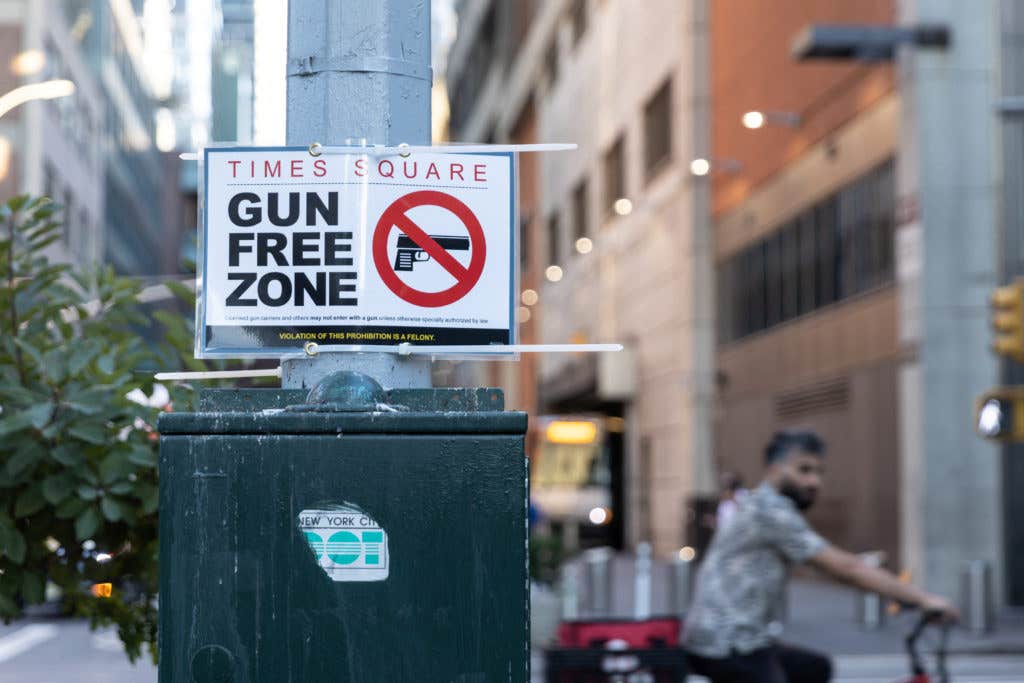Gun-free zones do not attract mass shootings, study finds
Gun-free zones may not be as dangerous as once thought. A groundbreaking study reveals these areas could actually reduce the likelihood of mass shootings.

People walk past a sign that reads “gun free zone” at Times Square. (CREDIT: REUTERS / Jeenah Moon)
A new study from UC Davis Health challenges the common belief that gun-free zones make public spaces more vulnerable to shootings. This groundbreaking research, published in The Lancet Regional Health Americas, suggests that gun-free zones could actually reduce the risk of mass shootings, contradicting the often-cited claim that these areas attract shooters.
According to the study's first author, Paul Reeping, a postdoctoral scholar and injury epidemiologist at the Violence Prevention Research Program at UC Davis, “Our most significant finding is that gun-free zones don't attract active shooters. The study actually shows that gun-free zones have a preventive effect. The biggest takeaway is that the claim that gun-free zones are more dangerous is simply not true.”
Understanding Gun-Free Zones
Gun-free zones are areas where carrying firearms is prohibited, though the rules governing them vary by state and local statutes.
For instance, in Texas, any establishment that generates more than 50% of its revenue from alcohol sales is considered a gun-free zone. While most people associate these zones with places like schools, theaters, or stadiums, private businesses also have the discretion to enforce such policies.
The question of whether gun-free zones make public spaces safer or more dangerous has been a heated topic in political and public discussions, particularly in the aftermath of mass shootings. However, prior to this study, no quantitative research had directly tested whether these zones truly deter or attract shooters.
A Novel Research Approach
This study, conducted in collaboration with researchers from Columbia University and the University of Michigan, used a unique design to examine 150 locations across the U.S. where shootings took place between 2014 and 2020. These locations included various public spaces and businesses, both gun-free and gun-allowing.
Related Stories
To create a fair comparison, the researchers identified 150 similar locations that had not experienced shootings, using factors such as the type of establishment, the county it was in, and the year. These locations served as the control group, offering a direct contrast to the places where shootings had occurred.
“For a long time, people didn’t think this work could be done,” Reeping said, explaining the study’s novel methodology. “We used a unique design that matched places based on similar criteria but very different outcomes — in this case, shootings.”
Gun-Free Zones: A Potentially Protective Measure
The study's results were telling. Of the 150 places that experienced shootings, 72 (48%) were designated as gun-free zones. Meanwhile, of the 150 locations that had not experienced shootings, 92 (61.3%) were gun-free. The researchers then adjusted for various factors to determine whether gun-free zones were a protective factor or not.
Their analysis revealed a key insight: shootings were 62.5% less likely to occur in gun-free zones than in places where firearms were allowed. “It is very unlikely that active shooters are targeting gun-free zones; conversely, gun-free zones may be protective,” Reeping explained.
This finding turns the traditional narrative about gun-free zones on its head. Instead of acting as magnets for violence, these areas may actually decrease the likelihood of a shooting. These results could have far-reaching implications for public policy, particularly in the ongoing debate over where firearms should be allowed in public.
Implications for Policy
The policy landscape around gun-free zones has been evolving, especially since the Supreme Court’s 2022 decision in New York State Rifle & Pistol Association v. Bruen (Bruen decision). This ruling upheld the right of Americans to carry loaded firearms in public, but it also left room for certain restrictions, such as the designation of gun-free zones. These carve-outs are still being challenged in courts across the country, with varying results.
Given these legal battles, the findings of this study may influence future court decisions and public policy discussions. If gun-free zones are indeed safer than places that allow firearms, as the study suggests, lawmakers and communities may have more evidence to support maintaining or expanding these zones.
Still, more research is needed to fully understand the implications. As Reeping noted, “This is the first time this type of study has ever been done, and we hope more will follow. Most people believe gun-free zones are actually more dangerous, and the evidence from our study doesn’t support that.”
Further Studies and Collaboration
The team behind this research is made up of experts from several prestigious institutions. In addition to Reeping, the study’s co-authors include Christopher N. Morrison, Charles C. Branas, Ariana N. Gobaud, and Sonali Rajan of Columbia University, as well as Douglas J. Wiebe of the University of Michigan. Their collective expertise in epidemiology, public health, and violence prevention strengthens the credibility of the study’s findings.
Future studies could build on this research by exploring the long-term effects of gun-free zones on public safety and determining whether specific types of gun-free zones, such as schools or places of business, are more effective at preventing shootings than others. As the debate over gun control continues, these findings provide a fresh perspective on an issue that affects communities nationwide.
In the meantime, this study challenges a widely held belief and provides a data-driven counterpoint to the argument that gun-free zones increase the risk of shootings. As more research emerges, it will become clearer whether gun-free zones are a key tool in preventing mass shootings or if other measures should be considered alongside them.
Note: Materials provided above by The Brighter Side of News. Content may be edited for style and length.
Like these kind of feel good stories? Get The Brighter Side of News' newsletter.



